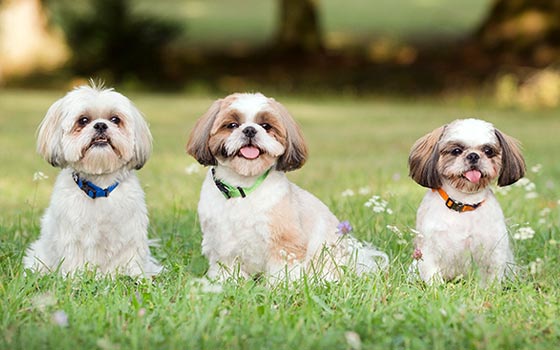Lifespan
10 to 16 years
By : Trupanion Staff | Updated Mar 21, 2024
Lifespan
10 to 16 years
Weight
9 - 16 pounds
Energy level
Couch potato
Mall walker
Breed Group
Toy
There's a good chance you're familiar with these sweet, small dogs. But how much do you really know about them?

Shih Tzus are sweet and love life! They take their noble origins seriously and love to be pampered — definitely living up to their responsibility as “royal lap dog!” But don’t let their glamorous appearance fool you — they’re quite sturdy little dogs. They love to play and will bond closely with their family.
The Shih Tzu is an ancient breed, originating in Tibetan monasteries and often given to Chinese royalty as gifts. They’re seen in tapestries dating back more than 2000 years! These dogs were so cherished by many Chinese dynasties that they lived in the royal court and were kept hidden from the public eye. Shih Tzus were companion dogs and considered “warmers” for their humans, often kept in sleeves or placed on the feet of royalty to help generate heat.
Empress Tzu Hsi (Cixi) was gifted a breeding pair of Shih Tzus by the Dalai Lama, when she came to power in the late 1800s, and started a strict breeding program to create her ideal “Imperial Dog.” After she died, the breeding program was discontinued and the breed almost went extinct.
The Shih Tzu made its way to the United States when American soldiers stationed in Europe and Asia brought them home after World War II. The American Kennel Club officially recognized the Shih Tzu breed in 1969 and they have become increasingly popular as family pets and companions.
Shih Tzus were bred as alert dogs, trained to let larger guard dogs know someone was approaching by barking. But they found their niche as the perfect lap dog for Chinese royalty. They love being companions, which makes training a joy with this fun-loving breed. They’re smart and quite athletic, even at their small size, and love to learn new things (although it can take them some time to truly “get it.”)
Shih Tzus are known for being outgoing and social. Proper proactive exposure to new sights, sounds, people, dogs, and other animals as a young puppy is essential for their socialization.
They’re known for doing well with children, due not only to their sweet nature but also their sturdiness. Make sure they’ve been properly introduced and socialized with children as a puppy to set them up for success. Young children and dogs should always be supervised, and it’s helpful for a dog to have their own “safe space” where they can go when they need some quiet time.
Shih Tzus can enjoy the companionship of other animals in the home, as long as they have been properly socialized since puppyhood and introduced.
As a small breed, Shih Tzus don’t require a high level of physical exercise to stay in shape. They do best with a short daily walk and a little play time with their human family or other dogs in the home. You might see them get the “puppy zoomies” every once in a while, which is completely normal (and pretty funny). Heavy exercise, or exercise in warmer temperatures, should be avoided to prevent health issues and heatstroke. Shih Tzus, like all flat-faced breeds, should always be monitored for heatstroke symptoms, which often include: heavy panting, drooling, bright red tongue or gums, rapid pulse, and wide, panicked eyes.
While their physical exercise needs are minimal, Shih Tzus need lots of mental enrichment to keep their minds engaged and prevent unwanted puppy behaviors (such as destructive chewing). Daily training for obedience and tricks are a great way to provide enrichment and keep their brain sharp, as well as providing puzzles or other interactive toys.
Shih Tzus enjoy activities that keep them close to their human and require a little quick thinking:
Shih Tzus have a long and dense double coat. When left long, they often sport a fashionable top knot to keep the hair out of their eyes to prevent irritation.
The Shih Tzu coat is high maintenance and needs consistent upkeep to prevent matting. Daily brushing, especially of the top knot and beard, and regular bathing is needed to keep the coat clean. Dirty coats are much more likely to tangle.
Many owners prefer to keep the coat shorter, to simplify maintenance. This is best done through regular professional grooming. Introducing your Shih Tzu puppy to positive grooming and handling while they’re young will make their lifelong grooming needs easy for everyone.
Best brush for a Shih Tzu: Pin comb, Pin brush, Slicker brush
The breed has gained global popularity over the years and is adored for its friendly nature and glamorous appearance. Is it any wonder the dog has been spotted many times in pop culture?